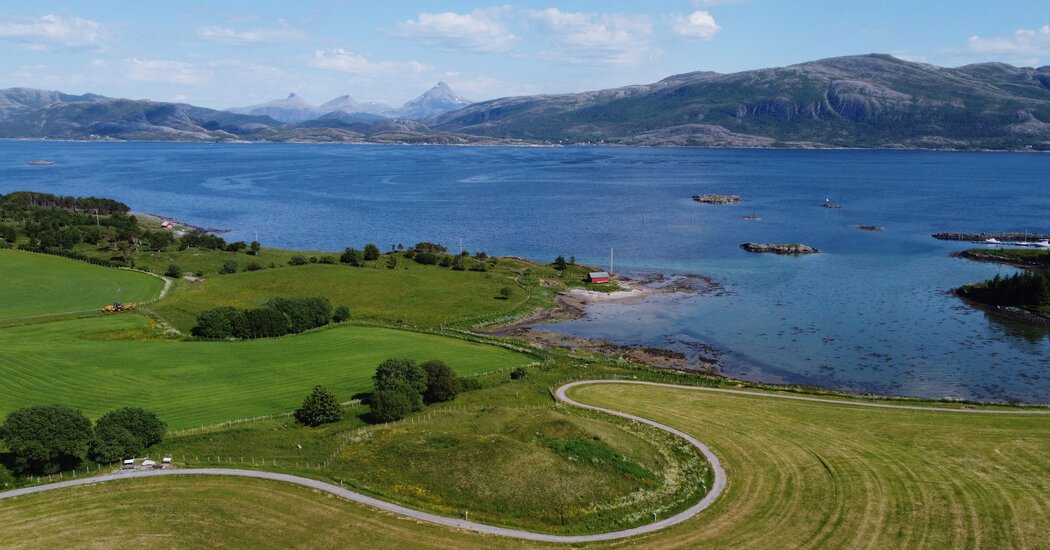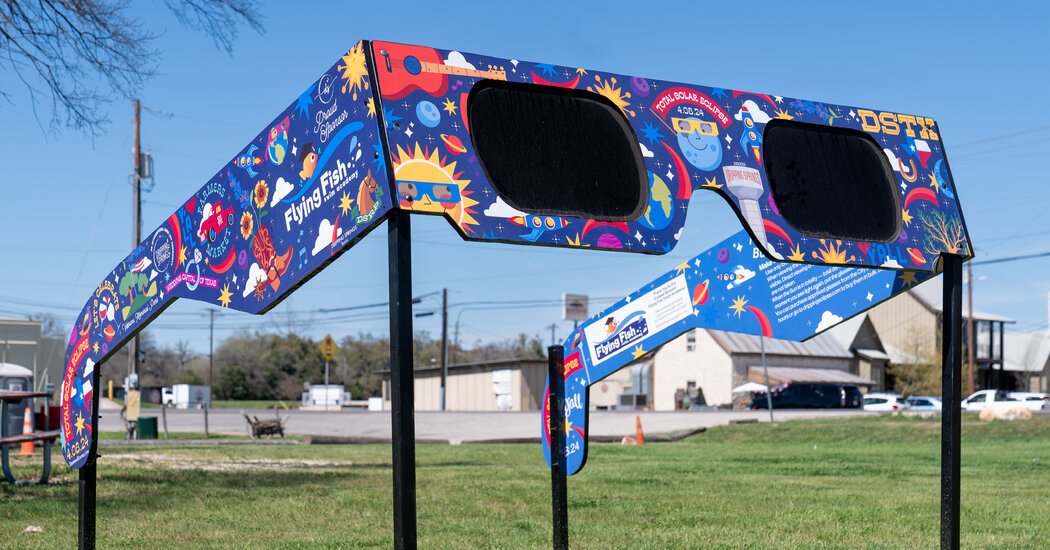For hundreds of years, Norwegians thought they knew who or what had been interred in an enormous barrow on the island of Leka, which is just off the country’s northern coast, facing the Atlantic Ocean. The grassy hillock is named for King Herlaug, a ninth-century Viking monarch who, if the Norse folklore is to be believed, had himself and 11 companions buried alive rather than face certain defeat by a rival ruler.
The story of the mass suicide has been regarded as potentially factual since the late 1700s, when three tunnels were bored into the burial mound, revealing nails, animal bones, a bronze cauldron and a seated skeleton with a sword. The human remains, notionally identified as Herlaug, were exhibited with other artifacts from the barrow for a time at the nearby Trondheim Cathedral School before disappearing altogether in the early 1920s and leaving an unresolved puzzle. Evidently, the cauldron was melted down into shoe buckles.
Last summer, archaeologists and a metal detectorist conducted a small survey of the tumulus on behalf of the Norwegian Directorate for Culture Heritage. They were attempting to determine whether the barrow — originally 41 feet high and 230 feet in diameter — harbored a ship, as scholars had long suspected. “We know very little about what these large mounds contain because hardly any of them have been investigated,” said Geir Grønnesby, an archaeologist at the Norwegian University of Science and Technology who supervised the dig.
The researchers dug three shallow trenches at the site and unearthed wood fragments and iron planking rivets that were thought to have once been part of a ship. Although the vessel had largely rotted away, radiocarbon dating of the wood around some of the rivets and the two charcoal layers high up in the mound indicated that the burial had occurred around 700 A.D., making it the earliest known example of a ship burial in Scandinavia.

The ship’s grave predates the Viking Age, which lasted from 793 A.D. to 1066 A.D., by several generations — scuttling the theory that the site, known as Herlaugshaugen, was the final resting place of King Herlaug and his suicide squad. But the find established that the eighth-century inhabitants of the north-central coast were “skilled seafarers who could build big ships,” Dr. Grønnesby said. It also challenged historical narratives by pushing back the tradition of vessel graves in Norway, aligning it with such spectacular early examples as the boat burials of Valsgärde, in the Swedish province of Uppland, and the ship burial of Sutton Hoo, in the county of Suffolk, England. Archaeologists differentiate between Old Norse boats and ships based on length, but they don’t agree on where to draw the line; some say 39 feet, others say 46 feet.
Valsgärde today is a farm near the Fyris River, and from the sixth to the 11th centuries it hosted a series of burials in boats equipped with all the necessities a great warrior required in the afterlife: cooking gear, horses, ornate shields, helmets, weapons, feather beds and pillows.
Sutton Hoo encompasses about 20 burial mounds, one of which includes the imprint of an 89-foot-long, clinker-built rowing boat from the seventh century. Historians generally agree that Sutton Hoo was the cemetery for the royal dynasty of East Anglia, the Wuffingas, and that the ship burial in Mound One commemorated the death in 624 A.D. of Raedwald, an Anglo-Saxon king who converted to Christianity (albeit not with complete conviction — he kept a shrine with altars to both Christ and the pagan gods). Mound Two, damaged by looters, may have held his son or nephew and possibly a small boat.
Jan Bill, who is the curator of the Viking ship collection at the University of Oslo and was not involved with the Herlaugshaugen project, said that if the timeline holds up, the results will “be part of a growing amount of evidence that the use of ship symbolism in royal burials started already back in the late sixth or seventh century in Scandinavia, even if the earliest examples in Norway so far date back only to the eighth century.”
Barrow building
Norway abounds in grave mounds. A 2017 study determined that nearly 2,300 such mounds are wider than 66 feet at the base. Some, like the one that used to stand at another site at Inderøy, had a fairy-tale-like mystique. Legend has it that a king conquered Inderøy in battle and installed a dog named Saurs on the throne. The locals used magic to instill the knowledge of three wise men into the animal, whose enchanted if not enlightened rule lasted for years. When the dog eventually met its maker, it was buried in a barrow called Sakshaug, Norwegian for Saur’s mound.
Dog barrows seem to have been less common than boat barrows, which were once a fairly standard funerary structure throughout Scandinavia, where the deceased were laid in vessels and given grave offerings in keeping with their social status. Heaps of stone and soil were typically placed atop corpses to create barrows. Dr. Grønnesby said that many of ancient Norway’s monumental mounds were built for the power elite as symbols of wealth and prestige, and located in places where passers-by couldn’t miss them.
Herlaugshaugen, situated on the coast, was a key stop in the trade of goods to mainland Europe and visible to everyone who sailed past it. “We can probably say that the mounds were built to show off greatness, and that the ship was linked to religious ideas about life after death,” Dr. Grønnesby said. “The ship was a means of transport to the underworld.”
The Herlaugshaugen discovery throws new light on the Merovingian period, which lasted from roughly 550 to 793 and was the precursor to the Viking Age. It remains a remarkably hazy era of the region’s history that, despite having set off the ship-burial craze, has yielded few archaeological relics. In Norway, many of today’s farms are in the same spots they occupied 1,400 years ago. “However, we have carried out few excavations of farmyards,” Dr. Grønnesby said.
What have been excavated are huge, multifunctional Scandinavian long houses like the one in the epic Old English poem “Beowulf,” which opens with a description of how Scyld Scefing, the mythical first king of the Danes, was laid out in a richly furnished funeral boat cast off into the sea from where he had come. “In these halls are often so-called gold foil figures, small gold plates with pagan motifs,” Dr. Grønnesby said. “Often the plates depict a woman with a cup and a man facing each other.”
Similar decorative plates, with larger and more saber-rattling designs, were found on helmets at Valsgärde and Sutton Hoo. “These motifs are usually interpreted in the light of Norse mythology,” Dr. Grønnesby said.
Herlaugshaugen’s bronze cauldron was discovered during the first excavation, in 1755, when the mound was thought to contain the remains of a giant named Herlo. Little is known about the ship presumed to have been buried there, although the rivets discovered recently suggest it was probably comparable in length to two ninth-century ships — the Oseberg and the Gokstad, 71 and 78 feet long, respectively — found in burial mounds in Vestfold, Norway. “The first excavation of Herlaugshaugen in 1755 found a hole that went through the mound,” Dr. Grønnesby said. “In light of the legend, this was interpreted as an air vent.” The current theory proposed that the hole was the imprint of a mast and that, in any event, the ship was interred in the mound at least 150 years before the royal embedment supposedly took place.
Or not to be
In “Heimskringla,” the bloody and blackhearted sagas of the Old Norse kings, the 13th-century Icelandic sage Snorri Sturluson told of Herlaug and Hrollaug, brothers who jointly reigned over the petty kingdom of Naumudal, which included the island of Leka. The kings had the misfortune of governing during the time of Harald Fairhair, an ambitious warlord who swore that he would not cut his hair until he had united all of Norway under one monarchy — a pledge that begot the nickname Lufa, or Shockhead.
According to Sturluson, Herlaug and Hrollaug spent three summers raising a massive burial mound of stone, lime and wood. Just as the work was completed, word came that Harald and his formidable army were headed their way. Resigned to defeat, Hrollaug joined the enemy. But Herlaug refused to submit and, instead, had great quantities of meat and drink brought into the tomb. Then he went inside with 11 of his men and, in a final act of defiance, ordered the shelter to be sealed shut.
Many rulers throughout history have dug their own graves figuratively, but perhaps only King Herlaug did so literally.










